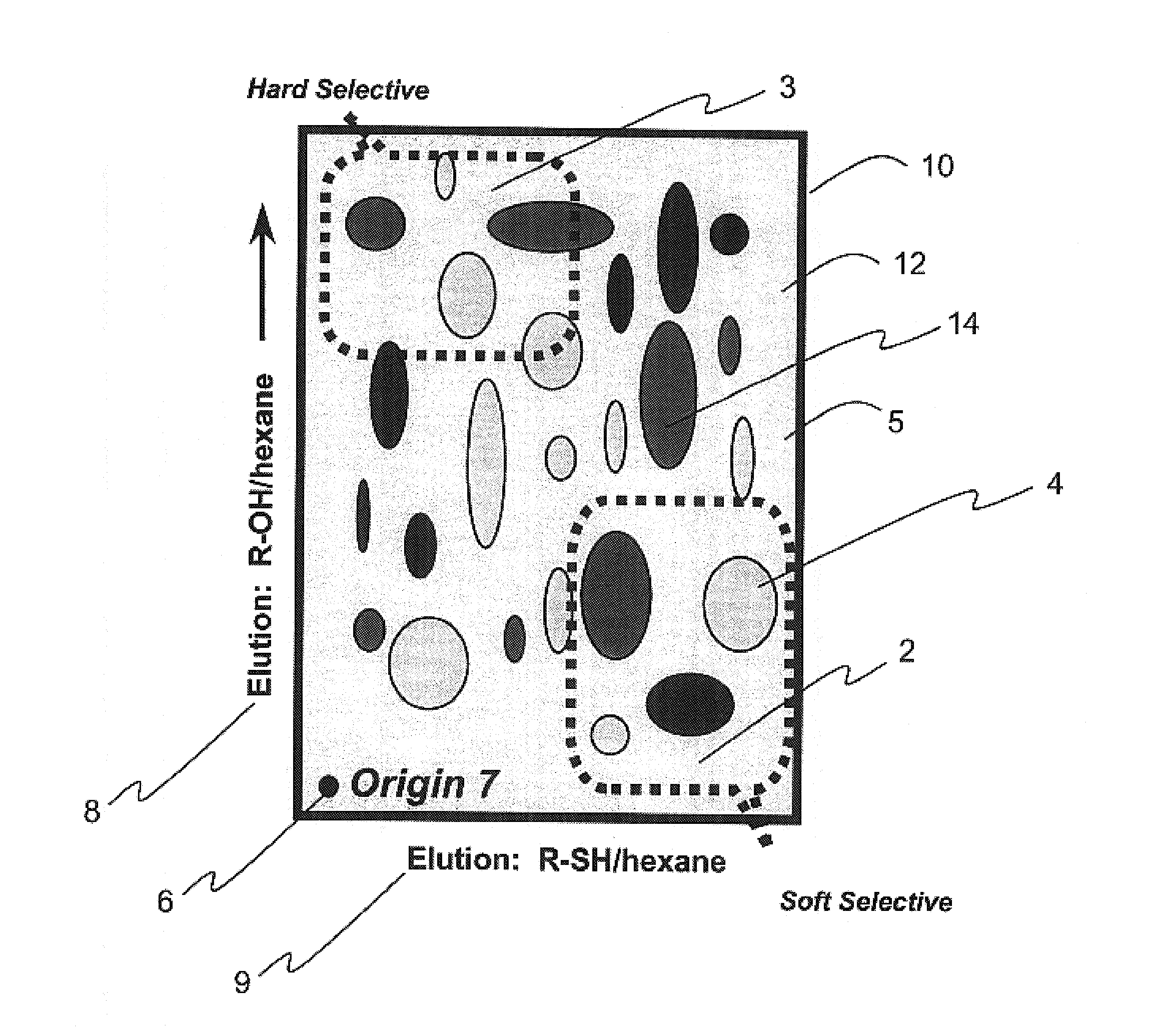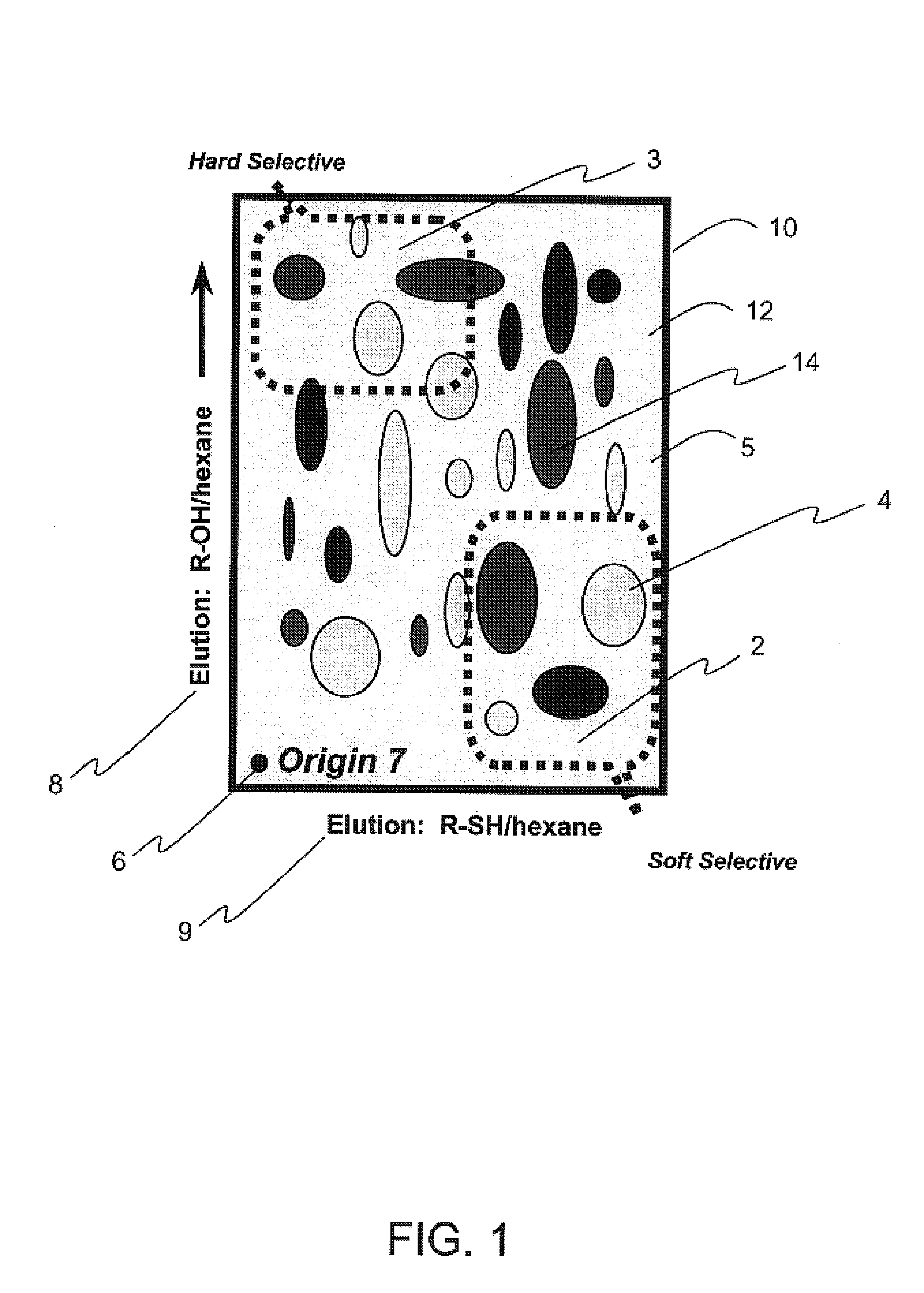Colorimetric artificial nose having an array of dyes and method for artificial olfaction
a colorimetric and artificial nose technology, applied in the field of artificial olfaction methods and apparatuses, can solve the problems of inability to selectively target metal-coordinating vapors and toxins, severe limitations and disadvantages of conventional artificial noses, and are not considered generally useful for such purposes, and achieve the effects of low odorants, expensive signal transduction hardware, and low cos
- Summary
- Abstract
- Description
- Claims
- Application Information
AI Technical Summary
Benefits of technology
Problems solved by technology
Method used
Image
Examples
example 1
[0054]Scanning at different time intervals and subtracting the red, green and blue (“RGB”) values of the new images from those of the original scan yields a color change profile. This is shown for n-butylamine in FIG. 4, in which color change profiles of the metalloporphyrin sensor array 16 as a function of exposure time to n-butylamine vapor. Subtraction of the initial scan from a scan after 5 min. of N2 exposure was used as a control, giving a black response, as shown. 9.3% n-butylamine in N2 was then passed over the array and scans made after exposure for 30 s, 5 min., and 15 min. The red, green and blue (“RGB”) mode images were subtracted (absolute value) to produce the color change profiles illustrated. Virtually all porphyrins are saturated after 30 seconds of exposure, yielding a color fingerprint unique for each class of analytes, which is illustrated in FIG. 4.
[0055]More specifically, subtraction of the initial scan 40 from a scan after 5 min. of N2 exposure was used as a c...
example 2
[0059]Visible spectral shifts and absorption intensity differences occur upon ligation of the metal center, leading to readily observable color changes. As is well known to those with skill in the art, the magnitude of spectral shift correlates with the polarizability of the ligand; hence, there exists an electronic basis for analyte distinction. Using metal centers that span a range of chemical hardness and ligand binding affinity, a wide range of volatile analytes (including soft ligands, such as thiols, and harder ligands, such as amines) are differentiable. Because porphyrins have been shown to exhibit wavelength and intensity changes in their absorption bands with varying solvent polarity, it is contemplated that the methods and apparatus of the present invention can be used to calorimetrically distinguish among a series of weakly ligating solvent vapors (e.g., arenes, halocarbons, or ketones), as shown for example in FIG. 5.
[0060]A comparison of color changes at saturation for...
example 3
[0064]The array of the present invention has demonstrated interpretable and reversible responses even to analyte mixtures of strong ligands, such as pyridines and phosphites, as is shown in FIG. 6. Color change patterns for the mixtures are distinct from either of the neat vapors. Good reversibility was demonstrated for this analyte pair as the vapor mixtures were cycled between the neat analyte extremes, as shown in FIG. 6, which shows the two component saturation responses to mixtures of 2-methylpyridine (“2MEPY”) and trimethylphosphite (“TMP”). Vapor mixtures were obtained by mixing the analyte-saturated N2 streams at variable flow ratios. A single plate was first exposed to pure trimethylphosphite vapor in N2 (Scan A), followed by increasing mole fractions of 2-methylpyridine up to pure 2-methylpyridine vapor (Scan C), followed by decreasing mole fractions of 2-methylpyridine back to pure trimethylphosphite vapor. In both directions, scans were taken at the same mole fraction tr...
PUM
 Login to View More
Login to View More Abstract
Description
Claims
Application Information
 Login to View More
Login to View More - R&D
- Intellectual Property
- Life Sciences
- Materials
- Tech Scout
- Unparalleled Data Quality
- Higher Quality Content
- 60% Fewer Hallucinations
Browse by: Latest US Patents, China's latest patents, Technical Efficacy Thesaurus, Application Domain, Technology Topic, Popular Technical Reports.
© 2025 PatSnap. All rights reserved.Legal|Privacy policy|Modern Slavery Act Transparency Statement|Sitemap|About US| Contact US: help@patsnap.com



